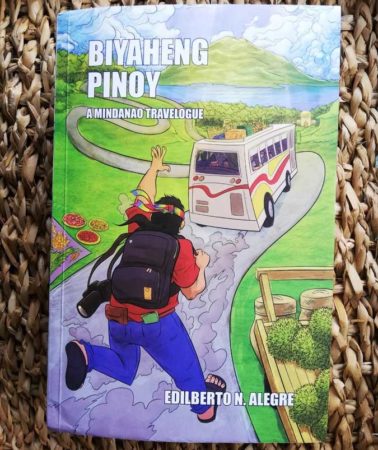UNDERSTANDING and knowledge of a culture is achieved through immersive experience. The value of that knowledge widens when it is recounted in words for others to read.
In the book Biyaheng Pinoy: A Mindanao Travelogue, author Edilberto N. Alegre chronicled his extensive travels in Mindanao in 36 essays. He wrote of places of great interest, his interactions with and lessons learned from indigenous people, and the distinctive ways of cooking food and how ingredients are sourced. These essays were distillations of source materials for his cultural research.
During the online book launch on Feb. 18, streamed through the Ateneo de Manila University’s YouTube page, Joycie Dorado-Alegre, the late author’s wife and a professor at the University of the Philippines Visayas Tacloban College (UPVTC), recalled that it took 30 years since Mr. Alegre first journeyed South and 11 years after his death to get the manuscript ready for publication.
“To set forth on that journey to answer his own questions, he found some answers as there were new questions,” she said.
In the book’s Preface, Ms. Alegre wrote: “Biyaheng Pinoy was to cap off his series of intense and extensive writing on the various domains of Philippine culture. Other than the books on literary history and food he co-authored with the late Doreen G. Fernandez, his previous solo publications were Inuman Pinoy (Anvil, 1992), Pinoy Forever (Anvil, 1993), and Pinoy na Pinoy (Anvil, 1994). In 1999, 10 years after his initial field visit in the south, he felt he had enough material for a new book….
“Sadly, Eddy did not live long enough to complete the work. He passed on in January 2009 after putting his Biyaheng Pinoy drafts in order. Later, I worked over his manuscripts to have them published as he had wished.”
Some of the essays were unfinished and Ms. Alegre and the book’s editor, Ricky de Ungria, had to cobble together what he had written into manageable form. Mr. De Ungria is quoted as saying in the Preface: “ ….what was given me was not a finished draft of a book but a disorganized satchel of completed studies and field notes. Working on it would be like working on the internet before there was Google… But because Ed was probably the only one in his time who was doing such critical reflexive meditations that could be useful for present and future researchers, it might be good to have them too in the book… Such a design for a book is virtually a kind of intellectual biography.”
“The book shows the dynamic between theory and research — to see what everybody else has perhaps seen, yet think what nobody else has thought. This book therefore documents an active curious mind at work,” Karina A. Bolasco, director of the Ateneo University Press said.
Edilberto Alegre (1938-2009) was born in Naujan, Oriental Mindoro. As a Monbusho scholar, he earned a bachelor of arts, master of arts, and doctor of philosophy in Japanese language and literature at the Kyoto University in Japan. He taught at the University of the Philippines (UP), Notre Dame Women’s College in Kyoto, and Ateneo de Manila University. He was also an English teacher in Madrid, Spain. Mr. Alegre was a BusinessWorld columnist for almost 19 years, writing the column “Pinoy na Pinoy’’ where he tackled various elements of Filipino life — from food to aging — much of which was based on his nationwide cultural research. Many of those essays are included in Biyaheng Pinoy: A Mindanao Travelogue.
Jay Jomar F. Quintos, who worked on a literary analysis on the author’s writings, read from Mr. Alegre’s book during the launch. “There is a valuable lesson in cultural theorizing — rely on concrete data. These concrete data can be the words, and syllables uttered, food consumed, scene or places observed, and a performanced witness. A researcher can sometimes go wrong with a theory but never in concrete data gathered from the field,” Mr. Alegre wrote.
“The book is not just a travelogue but a theoretical book that bridges the discursive, and the popular. He frames and reframes, mediates, structures and restructures, constitutes and reconstitutes the different ways of seeing and reading data that reflect Philippine cultures,” Mr. Quintos said of Mr. Alegre’s essays.
Ms. Dorado-Alegre recalled how her late husband’s travel to Mindanao and interaction with the locals there led him to discoveries about our national culture. “Ed Alegre shares his joy in expanding his knowledge through travels and discovering Philippine culture. All we need is to see the similarities over the differences,” Ms. Dorado-Alegre said in Filipino.
Biyaheng Pinoy — A Mindanao Travelogue (P750) is available through the Ateneo Press (https://www.ateneo.edu/ateneopress/) and the Ateneo Press Lazada and Shopee stores in paperback and ebook versions. — Michelle Anne P. Soliman

